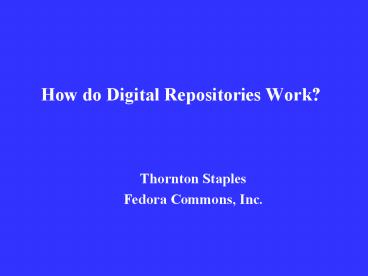How do Digital Repositories Work - PowerPoint PPT Presentation
1 / 12
Title:
How do Digital Repositories Work
Description:
How do Digital Repositories Work? Thornton Staples. Fedora Commons, Inc. ... Is it about use and re-use of the content or just preservation? ... – PowerPoint PPT presentation
Number of Views:57
Avg rating:3.0/5.0
Title: How do Digital Repositories Work
1
How do Digital Repositories Work?
- Thornton Staples
- Fedora Commons, Inc.
2
What do we mean, Institutional Repository
- Is it a place to cherish some PDF files?
- Is it about use and re-use of the content or just
preservation? - Is a repository part of a network of
inter-related repositories? - Is a repository used to construct and manage the
publication from the beginning?
3
What is the nature of the publication?
- A PDF file?
- An illustrated narrative?
- A science article that includes datasets?
- A virtual exhibition?
- An electronic critical edition?
- Does it support annotation and other social
participation?
4
Beyond a PDF....
- These entities are usually heterogeneous
combinations of more than one type of content - The can include complex relationships among the
content components - They will increasingly include components that
are not under the control of the author or
sponsoring institution - Increasingly, they will include as components, or
have important relationships to, born-digital
content, not just surrogates for physical objects
5
Repository Systems
- EPrints is a vertically integrated application
that is specifically oriented around documents
and articles - DSpace is also a vertically integrated
application that has a more general conception of
content - If the content that you are managing fits their
models both provide a reasonably complete system
for managing it. - Fedora is a foundation of services upon which
many information management applications can be
built - Applications built upon Fedora for
domain-specific information management are
beginning to appear
6
Persistent Identifiers (PIDs)?
- Names for resources that uniquely identify them
without respect to their location - One of the main jobs of a repository is to manage
the content on the back-end, while publicly
maintaining the PIDs - A repository can maintain a unique PID for an
object that is then exposed using one or more
schemes
7
Workflow
- Provide submission processes that enforce content
and metadata standards at ingestion - Relationships among the content components must
be maintained throughout the process - Audit trails for actions on the repository must
be maintained - It is important to maintain versions of content
upon updating - Should provide for review and approval processes
- Social processes require a complete workflow
8
Discovery and Access
- Expose metadata or full-text to harvesting
services, such as Google or OAI - Provide specialist access to indexed metadata or
full text - As publications become more complex, more
metadata standards will have to be supported - Endlessly federating searches does not seem to be
the answer
9
Use and Re-use of Content
- The point of searching is finding!
- Content should be available in flexible ways to
be used by an array of tools - Content discovered in one context should be
reusable in another - The repository must be able to exchange content
with other repositories
10
Sustaining Digital Information
- Preserving the components such that they can be
reloaded in case of loss - Keeping the data technically viable, migrating
the content to new encodings, as necessary. - Vouching for the veracity and authenticity of the
information, both content and structure - Relationships to content that is outside the
repositories control must be maintained or
gracefully degraded
11
Establishing and Enforcing Policies
- Policies must be established for the entire
life-cycle of the information - Ownership and workflow policies
- Access and use policies
- Policies associated with sustaining (or not!)?
- Policy information can be based on assumptions
built into the software, encoded in metadata to
be handed off to other processes, and/or managed
and used as data in the repository - Polices must be expressed for end users
- Policies must also be expressed for machine access
12
Towards Community Repositories
- The repository becomes the medium for scholarly
communication within a network - Content creators own their content and control
all policies associated with it - Authorship becomes a process of adding nodes and
arc to a worldwide network of content - Transfer ownership to other sophisticated
repositories (digital libraries?) to be sustained
in the long term - Community repositories could be hosted by
publishers or professional societies

